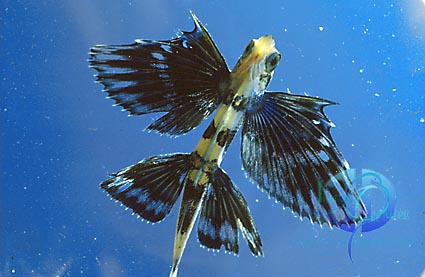|

Quite frequently, in high summer, one can spot certain
clumps of Gulf Weed that seem much more solidly packed than the
usual loose-bait bundles. Some are so solid as to appear impenetrable.
Each is usually about the size of a football. Upon close inspection
the immediate impression is of something not very nice! The ball
appears to be riddled with fungus and possibly something that has
died and is beginning to decompose. In fact it is the exact opposite.
This apparently moribund ball is positively throbbing with life
- new life!
The object in question is a nest and appropriately
its designer and builder flies……..but it's a fish! These balls are
flying fish nests and they are full of developing eggs - each with
perfect pepper and salt coloured fish embryo within, complete with
heart, eyes, ears (otoliths) and segmented body and tail. Beneath
the chin and wide mouth of each embryo beats a big heart, which
by week two is pumping bright red blood throughout the embryo. Periodically
the embryos wriggle violently and shift position. In late development
they are so beautiful and their well developed pigment cells in
brown, black, yellow and orange hint at the colour the emerging
larval flying fish will acquire for the first few months of its
life.

William Beebe (the same of Deep Sea fame) studied
these larvae thoroughly and he concluded that this was a species
not before described and therefore named by him the "Sargassum flying
fish". The adult which he noted was like a delicate moth, flitting
in and out of Sargassum clumps he refered to as the "Many-coloured
butterflying fish".
It took about forty or fifty years for Günther to
point out the error of Beebe's ways. He showed that indeed this
was the juvenile stage and early life stages of the 'Blue and Silver
Atlantic Flying Fish' - sometimes called the 'Four-wing Flying Fish'
- the one we see glide for up to four or five hundred metres at
a time when disturbed at the surface. These adults pair close by
Sargassum and while the female lays eggs and secretes silken threads
to enmesh both weed and eggs, the male, we suspect synchronously,
fertilises the brood by following the female in, through and around
the ever enlarging nest - a little reminiscent of the classic Three-spined-stickleback
process of courtship and fertilisation. I don't believe there is
any indication of internal fertilisation in this species and the
above process, though speculative, would appear to be one of the
few possible options. We would love to receive feedback on this
point if any readers have witnessed part, or all, of the process.
|